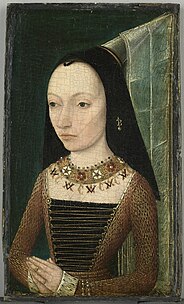 W
WAnna Pavlovna of Russia was a queen consort of the Netherlands.
 W
WElisabeth of Görlitz reigned as Duchess of Luxemburg from 1411 to 1443.
 W
WMargaret of Flanders was a Duchess consort of Brabant. She was the daughter of Guy of Dampierre and his first wife Matilda of Béthune.
 W
WIsabella of Portugal, also known as the Empress of the Carnation, was Holy Roman Empress, Queen consort of Spain, Germany, and Italy, and Lady of the Netherlands by her marriage to Emperor Charles V. She was the regent of Spain because of her husband's constant travels through Europe, ensuring that the kingdom remained independent of imperial policies and economically healthy during her lifetime. Her personal motto was aut Caesar aut nihil.
 W
WIsabella of Portugal was Duchess of Burgundy as the third wife of Duke Philip the Good. Born a Portuguese infanta of the House of Aviz, Isabella was the only surviving daughter of King John I of Portugal and his wife Philippa of Lancaster. Her son by Philip was Charles the Bold, the last Valois Duke of Burgundy. Isabella was the regent of the Burgundian Low Countries during the absence of her spouse in 1432 and in 1441–1443. She served as her husband's representative in negotiations with England regarding trade relations in 1439 and those with the rebellious cities of Holland in 1444.
 W
WJacqueline of Hainaut was a noblewoman who ruled the counties of Holland, Zeeland and Hainaut in the Low Countries from 1417 to 1433. She was also Dauphine of France for a short time between 1415 and 1417 and Duchess of Gloucester in the 1420s, if her marriage to Humphrey, Duke of Gloucester, is accepted as valid.
 W
WThe counts of Limburg ruled a medieval county with its capital at Limbourg-sur-Vesdre, lying between Liège and Aachen. They rose to prominence when one of them was appointed Duke of Lower Lorraine. Though Lorraine was later confiscated, the ducal title was kept within the family, transferred to the county of Limburg, and this was eventually ratified by the Holy Roman Emperor. Thereafter, the dukes of Limburg were one of several claimant lines of heirs to the title of the old duke of Lower Lorraine. Their title was eventually inherited by their competitors the dukes of Brabant, and became part of the large collection of titles of the Burgundian Netherlands, eventually passing to the Hapsburgs.
 W
WErmesinde I, reigned as Countess of Luxembourg from 1197 until her death in 1247.
 W
WMargaret of England was the tenth child and seventh daughter of King Edward I of England and his first wife, Eleanor of Castile. Her husband was John II, Duke of Brabant, whom she married in 1290, the year of her mother's death. Margaret and John had one child, John III, Duke of Brabant.
 W
WMargaret of York —also by marriage known as Margaret of Burgundy—was Duchess of Burgundy as the third wife of Charles the Bold and acted as a protector of the Burgundian State after his death. She was a daughter of Richard, 3rd Duke of York, and Cecily Neville, and the sister of two kings of England, Edward IV and Richard III. She was born at Fotheringhay Castle, Northamptonshire, in the Kingdom of England, and she died at Mechelen in the Low Countries.
 W
WSophie of Württemberg was Queen of the Netherlands as the first wife of King William III.